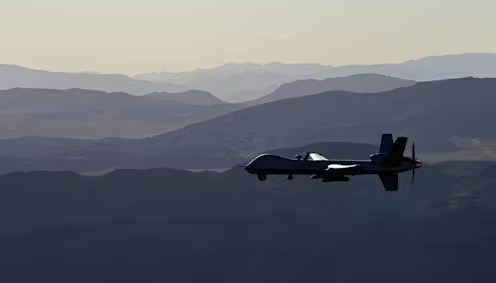Are drone strikes legitimate, meaning on sound moral and legal footing? How people perceive the legitimacy of U.S. drone strikes – firing missiles from remotely piloted aircraft at terrorist and insurgent leaders – is central to whether and how the government can continue to use them.
The American public tends not to question military action it perceives as rightful, and U.S. policymakers often reference the legitimacy of U.S. drone strikes. The U.S. military, responsible for conducting most drone strikes globally, has also adopted legitimacy as a principle of counterterrorism operations.
Yet what shapes perceptions of legitimate drone warfare, how these perceptions vary across audiences, and the implications for the U.S. drone program are not well understood. This gap is surprising, given that “over-the-horizon” drone strikes – firing missiles at targets many miles away – have defined U.S. counterterrorism policy in Afghanistan and elsewhere, despite being routinely criticized.
Drone strikes differ from other uses of force in the remoteness of the operators firing the weapons. Drone operators are typically hundreds or thousands of miles away from their targets, which they view through drone- and satellite-based cameras and sensors. In the worst-case scenario, this can lead to target misidentification and civilian casualties.
Part of the problem is that scholars disagree on what constitutes drone warfare, which has implications for how they understand variations in public perceptions of legitimacy. As military scholars who study the topic, we define drone warfare as a function of strike attributes, meaning how and why they are used abroad.
Using this definition, we have found that how a country uses and constrains the use of drones shapes how people perceive their legitimacy. We’ve also found that perceptions of legitimacy differ between U.S. citizens and soldiers, particularly chaplains, who guide the moral use of force. We are scheduled to present our study of the attitudes of military chaplains on drone strikes at both the U.S. Army’s Institute for Religious Leadership and the American Political Science Association’s annual meeting in September 2024.
A U.S. drone strike in Iraq in February 2024 killed three members of an Iranian-backed militia accused of an attack that killed three U.S. service members.
Uses and constraints
Countries use drones for different purposes.
Tactical strikes are designed to achieve battlefield objectives, such as destroying an enemy compound.
Strategic strikes destroy terrorist organizations to achieve overall war aims. They are used to remove key terrorist leaders. The goal of such “decapitation operations” is to hasten a terrorist group’s collapse.
Countries also constrain drone use differently. Some use self-imposed constraints. These include targeting standards, which are calibrated to balance effectiveness against anticipated civilian casualties. Others use externally imposed constraints such as international approval for drone strikes.
One of the authors gave a presentation about a book he co-wrote that examines public perceptions of the legitimacy of drone warfare.
US citizens’ beliefs
Drawing on our definition of drone warfare as a matter of varying uses and constraints of drones, we reviewed and analyzed public perceptions of the legitimacy of drone strikes.
We found that U.S. citizens perceive over-the-horizon drone strikes, where drones are used strategically without external oversight, as most legitimate. This pattern of drone warfare characterizes the United States’ approach globally.
However, we also found that U.S. citizens’ perceptions of legitimacy are affected by civilian casualties, which lead Americans to reconsider reliance on internal constraints such as targeting standards. Given civilian casualties, U.S. citizens’ perceptions of legitimacy are shaped by international, rather than national, oversight, reflecting a belief that international approval is central to the appropriate use of force.
A 2011 U.S. drone strike killed Anwar al-Awlaki, a U.S. citizen, sparking debate about the legitimacy of the attack.
US Army chaplains’ beliefs
We compared these results with the beliefs of U.S. Army chaplains, offering the first evidence for how these key advisers to military commanders perceive the legitimacy of drone warfare.
The U.S. Army conducts the most strikes of any service. Chaplains in the Army are “moral advocates” during conflict who “provide professional advice, counsel, and instruction on religious, moral, and ethical issues,” according to regulations. Many commanders in the military have strong religious beliefs, suggesting they may draw on chaplains’ counsel. Similarly, chaplains minister to drone operators, who are vulnerable to moral injury, meaning the emotional or psychological damage people suffer when they transgress their moral boundaries.
Some experts suspect that chaplains’ advisory role may be exaggerated. These scholars often study chaplains during interstate war, however. Our research sheds new light on chaplains’ attitudes toward the use of drones against nonstate adversaries such as terrorist organizations.
We found that, in contrast to the U.S. public, chaplains perceive over-the-horizon drone strikes as illegitimate. Rather, chaplains perceive tactical-level strikes on the battlefield as most legitimate, especially when they are tightly constrained by policy.
Even then, chaplains voice less support for these drone strikes than their perceptions of legitimacy might suggest. Why would chaplains not support drone strikes they perceive as legitimate? We found that this “legitimacy paradox” reflects underlying concerns. Chaplains in our survey often questioned the legality of strikes, the veracity of intelligence, the territorial integrity of targeted countries and the implications for national security.
The future of US drone warfare
These findings have implications for policy, strategy and military readiness. In order to increase perceptions of legitimacy of the U.S. drone program among citizens and soldiers, our findings suggest that elected and military leaders would need to take several steps.
First, elected officials would need to transparently discuss the program. Specifically, they would need to justify a transgression of a country’s sovereignty, especially in terms of anticipated security gains.
Second, military leaders would need to explain the intelligence driving drone operations, measures to protect civilians, and how strikes comply with international law.
Finally, military leaders would need to research the potential for differences in perceptions of legitimacy held by other soldiers, especially with the emergence of fully autonomous drones that can identify, track and engage targets without human oversight. Military lawyers, for instance, also fulfill a key advisory role to commanders. Lawyers’ training, shaped more by their understanding of the laws of armed conflict rather than moral considerations, suggests that it is possible they may interpret the legitimacy of drone strikes differently than chaplains.
In our expert opinion, taking these steps would bring the necessary transparency and reflection to address questions of legitimacy that are fundamental to civilian and military support for the U.S. drone program.



 OpenAI, SoftBank, and Oracle Unite for Exclusive AI Data Centers in the U.S.
OpenAI, SoftBank, and Oracle Unite for Exclusive AI Data Centers in the U.S.  Samsung Unveils Galaxy S25 with Advanced AI Features to Compete with Apple and Chinese Rivals
Samsung Unveils Galaxy S25 with Advanced AI Features to Compete with Apple and Chinese Rivals  Trump’s Commerce Nominee Howard Lutnick to Face Senate Hearing
Trump’s Commerce Nominee Howard Lutnick to Face Senate Hearing  Extreme heat, flooding, wildfires – Colorado’s formerly incarcerated people on the hazards they faced behind bars
Extreme heat, flooding, wildfires – Colorado’s formerly incarcerated people on the hazards they faced behind bars  Apple Downgraded by Jefferies Amid Weak iPhone Sales and AI Concerns
Apple Downgraded by Jefferies Amid Weak iPhone Sales and AI Concerns  Google Invests $1B More in Anthropic to Boost AI Race
Google Invests $1B More in Anthropic to Boost AI Race  Trump’s TikTok Order Sparks Legal Uncertainty for U.S. Tech Giants
Trump’s TikTok Order Sparks Legal Uncertainty for U.S. Tech Giants  SoftBank and OpenAI Lead $19B Investments in Stargate AI Initiative
SoftBank and OpenAI Lead $19B Investments in Stargate AI Initiative  Trump Dismisses Elon Musk's Criticism of $500B AI Project
Trump Dismisses Elon Musk's Criticism of $500B AI Project  Elon Musk Criticizes President Trump’s $500B Stargate AI Project
Elon Musk Criticizes President Trump’s $500B Stargate AI Project  Why your retirement fund might soon include cryptocurrency
Why your retirement fund might soon include cryptocurrency  Infosys Explores Talent Transformation Amid AI Advancements
Infosys Explores Talent Transformation Amid AI Advancements  What is a migrant? What is ICE? 10 terms to help you understand the debate over immigration
What is a migrant? What is ICE? 10 terms to help you understand the debate over immigration  Why Manchester City offered Erling Haaland the longest contract in Premier League history
Why Manchester City offered Erling Haaland the longest contract in Premier League history 

































